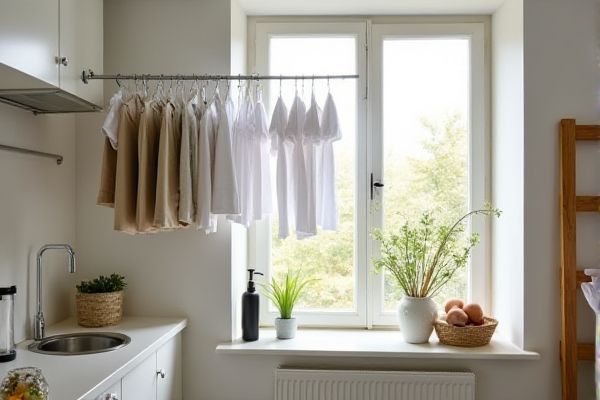
Ceiling-hung drying racks save valuable floor space and provide efficient air circulation for faster drying, while window drying racks are easier to install and allow natural sunlight to enhance the drying process. Discover which option best suits your home's layout and your drying needs by reading the rest of this article.
Table of Comparison
| Feature | Ceiling-Hung Drying Rack | Window Drying Rack |
|---|---|---|
| Installation Location | Mounted on ceiling indoors | Mounted on window frame |
| Space Efficiency | Utilizes overhead space, frees floor area | Uses window space, may limit window usability |
| Capacity | High - multiple rods for large loads | Moderate - limited by window size |
| Air Circulation | Good airflow indoors | Excellent natural airflow near window |
| Sun Exposure | Limited direct sunlight | High direct sunlight for faster drying |
| Installation Complexity | Requires ceiling mounting and hardware | Simple mounting on window frame |
| Retractability | Often retractable to save space | Usually fixed or foldable |
| Best Use Case | Indoor drying without window access | Maximizing sun and airflow |
Introduction to Drying Racks: Ceiling-Hung vs Window Styles
Ceiling-hung drying racks maximize vertical space by suspending clothes overhead, making them ideal for small rooms or apartments with limited floor area. Window drying racks utilize natural sunlight and airflow near windows, enhancing drying efficiency and energy savings. Choosing between these styles depends on available space, lighting conditions, and convenience preferences for indoor laundry drying.
Space Efficiency: Which Rack Saves More Room?
Ceiling-hung drying racks excel in space efficiency by utilizing overhead space, freeing up valuable floor and wall areas in your home. Window drying racks are limited to the window frame, often occupying window space and restricting natural light and ventilation. For optimal room-saving benefits, ceiling-hung drying racks provide a more practical and unobtrusive solution.
Installation: Ceiling-Hung vs Window Drying Racks
Ceiling-hung drying racks require secure mounting into ceiling joists or support beams, often involving more complex installation with the need for sturdy anchors and tools, making them ideal for rooms with sufficient ceiling height and space. Window drying racks typically install onto window frames or sills using brackets or suction cups, offering a simpler, less invasive setup suitable for smaller spaces or renters. Your choice depends on available space, structural support, and whether you prefer a permanent or easily removable drying solution.
Suitability for Different Home Layouts
Ceiling-hung drying racks maximize vertical space, making them ideal for homes with limited floor area or smaller laundry rooms. Window drying racks are best suited for apartments or homes with large, accessible windows that allow natural airflow and sunlight to aid drying. Both options provide space-saving solutions, but ceiling racks work better in compact interiors, while window racks complement well-lit, ventilated spaces.
Drying Performance and Airflow Comparison
Ceiling-hung drying racks provide superior drying performance by maximizing vertical space and allowing clothes to be spread out evenly, which enhances airflow circulation around each item. Window drying racks rely on natural window ventilation, but limited space and proximity to walls can restrict airflow, potentially slowing the drying process. Optimizing airflow with ceiling-hung racks reduces drying time and minimizes moisture buildup, making them more efficient for indoor drying.
Accessibility and Ease of Use
Ceiling-hung drying racks maximize floor space but often require reaching up or using a pulley system, making them less accessible for individuals with limited mobility. Window drying racks are installed at reachable heights, offering easier access and convenience for everyday use, especially in small spaces. Both types enhance drying efficiency, but window racks provide superior ease of use by eliminating the need to lift or lower heavy loads.
Aesthetics and Home Décor Impact
Ceiling-hung drying racks offer a sleek, minimalist appearance that blends seamlessly with modern interiors, maintaining open floor space and reducing visual clutter. Window drying racks, while practical, can interrupt natural light and view, potentially impacting the overall aesthetic and ambiance of your room. Choosing a ceiling-hung option enhances your home decor by preserving clean lines and an unobstructed environment.
Durability and Material Considerations
Ceiling-hung drying racks are typically constructed from robust materials like stainless steel or aluminum, offering superior durability and resistance to rust, making them ideal for long-term indoor use. Window drying racks often use lighter metals or plastic components that may be less durable and prone to wear from exposure to sunlight and moisture. Selecting a drying rack with corrosion-resistant finishes ensures longevity, while sturdier materials like metal alloys provide enhanced load-bearing capacity.
Price and Value for Money
Ceiling-hung drying racks generally offer better value for money due to their durable construction and space-saving design, with prices ranging from $30 to $100 depending on features and materials. Window drying racks tend to be more affordable, often priced between $15 and $50, but they provide less drying capacity and may not be suitable for larger laundry loads. Investing in a ceiling-hung drying rack maximizes drying efficiency and longevity, making it a more cost-effective choice for frequent use.
Which Drying Rack is Right for You?
Ceiling-hung drying racks maximize vertical space and are ideal for small rooms, offering adjustable height for convenience and efficient air circulation. Window drying racks utilize natural sunlight and ventilation, making them energy-efficient and perfect for fresh-drying clothes without taking up floor space. Choose a ceiling-hung rack if you need space-saving versatility indoors, while a window drying rack suits those who prefer eco-friendly drying with direct sunlight exposure.
 homyna.com
homyna.com